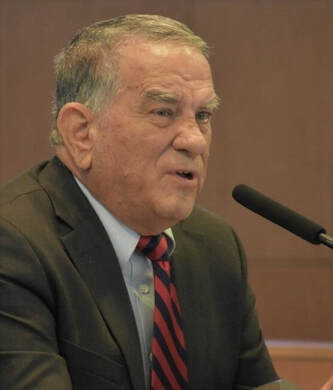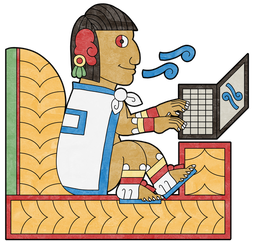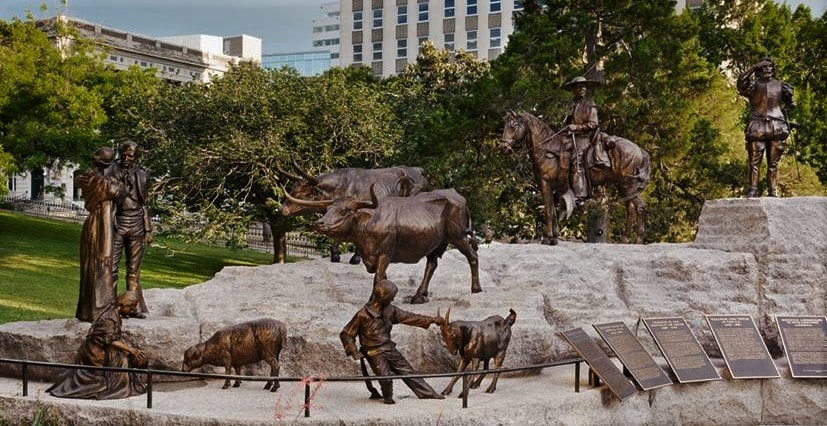Twelve things we should all know about TexasBy José Antonio López Joe Lopez has been writing columns about south Texas and Texas history in general for over ten years, along with contributing commentaries to various newspapers. He recently retired as a columnist for the online newspaper, Rio Grande Guardian International News Service. We plan to publish monthly the “Best of Joe Lopez” featuring his wit, his knowledge and commitment to telling the truth about the history of Texas. The opinions expressed in his columns are his own. (Full disclosure, the Editor of Somos en escrito Magazine is from San Antonio, Texas, but is unbiased in his views about his home state.) (Note: This article first appeared in the online newspaper, Rio Grande Guardian International News Service, July 2011.) Ever since the extremist super majority took over the Texas state legislature, they have embarked on a lock-step campaign to push for legislation that can only be described as limiting the freedom of Hispanic citizens in Texas. Their political agenda shows an underlying contempt, suspicion and distrust for any Texas attribute that is Spanish Mexican in nature. For example, a bewildered Texas state senator recently was visibly upset to learn that Spanish-surnamed Texans speak Spanish as their language of choice. Another extremist political leader in Austin complained that “the trouble in the Texas legislature is that there are too many Hispanics”. The question is what can explain their rancor against Texas Hispanics? In my view, they choose to ignore the common thread of Hispanic presence in Texas since its very foundation. Additionally, they confuse two different problems – (1) illegal immigration and (2) the rapidly browning of the Texas population. They unwisely believe the first problem causes the second. That is a false cause and effect picture. To begin, illegal immigration is wrong. However, it will be solved only when all the affected parties unite to develop a common solution. Now, let’s look at the second issue – the browning of the Texas population. Very clearly, the core of Hispanics in Texas is Spanish Mexican. So, let us call it what it is. This group is half white (Spanish = European) and half brown (Mexican = Native American). They are the direct descendants of the first citizens of Texas. They are not immigrants. This critical point is what separates our group from our other sister Hispanic groups, such as Cuban Americans and other groups from Central and South America and the Caribbean. Spanish Mexicans were once the majority in Texas and are now poised to once more regain that distinction. In short, the recent hateful legislation is ill advised and is due to blatant ignorance of Texas history. To that end, and with all due respect to our many supportive Anglo friends who know the full story, the details below are provided. 1. There was a Texas before 1836. Texas was not created by Anglo Saxon immigrants from the U.S. Nor is Texas the English name for Tejas. Both are Spanish names derived from a Native American Caddo tribe word meaning friend. The x sound in Texas is also pronounced as in México, Béxar, and Mexia. Texas was born in 1691. There were over 30 Spanish-surnamed Texas Governors between 1691 and 1821. 2. Beginning in the early 1700s, Spanish Mexican pioneers built thriving communities “Deep in the Heart of Texas” along El Camino Real (San Antonio, Nacogdoches, Goliad, and the Villas del Norte in the Lower Rio Grande). With skills they brought from Central and Northern Mexico, Spanish Mexican pioneers established the original ranchos. These first citizens of Texas also perfected the cowboy way of life in the state. This is why basic cowboy terminology is of Spanish language origin. After 1836, many of these Spanish words were Anglicized, such as ranch, cowboy, rodeo, corral, lasso, riata, cinch, ten gallon hat, remuda, mustang, etc… Unfortunately, movies and heavily Anglicized western novels have been very unkind to the Southwest Hispano Mexican culture. They continue to portray Spanish Mexicans only in minor and passive or negative roles. 3. San Juan Bautista Presidio, the “Gateway to Texas”. In 1699-1700, the San Juan Bautista Presidio was established along the Rio Grande in a pass of the river near present-day Guerrero, Coahuila and Eagle Pass, Texas. The Presidio was the only port of entry into Texas for the many families from Central and Northern Mexico who passed through its gates. Its ruins today serve as a reminder of the close relationship between Texas and (Coahuila) Mexico. Descendants of many of the early 1700s pioneer families throughout Texas have genealogical ties to San Juan Bautista. 4. Compañías Volante were the first Texas Rangers. As Spanish Mexican pioneers moved into Texas from elsewhere in Mexico, Spanish authorities were incapable of providing any more than the most minimum number of soldiers to provide security. As such, colonist leaders organized groups of citizen soldiers based in large ranchos and towns. Each team was then responsible for an assigned territory. Carrying only the most basic essentials, the team could literally fly off to any rancho being attacked by bandits. The lean and mean company became known as the Compañía Volante. Their legendary riding skills clearly characterize them as the Cossacks of Texas. When the Texas Rangers were established after 1836, the key role of the Compañía Volante was largely forgotten in the telling of Texas history. 5. The Emerald Green flag is the first flag of Texas Independence. The color was apparently chosen to honor Irish American Lieutenant Augustus McGee, Lt. Colonel Bernardo Gutiérrez de Lara’s protégée and chief military assistant during the initial part of the first Texas Revolution. Don Bernardo adopted the plain Emerald Green flag as the banner for the Army of the North (First Texas Army). Is the flag a legitimate flag of Texas Independence? The answer is yes. The facts are as follow: (l) Don Bernardo became the first President of Texas on April 6, 1813; (2), he wrote, signed and issued the first Texas Declaration of Independence; and (3) he wrote and issued the first Texas Constitution, modeled on the U.S. Constitution, on April 17, 1813. Oddly, even though it is the mother of all Texas independence flags, the Emerald Green Flag is not one of the six generally accepted flags of Texas. 6. The Battle of Medina fought on August 18, 1813, is the largest battle ever fought on Texas soil, according to the Texas State Historical Commission. Lt. Colonel Bernardo Gutiérrez de Lara’s hope of complete victory over the Spanish forces vanished quickly when he was betrayed by some members of his immediate military staff. Don Bernardo was relieved of command and forced into exile in Louisiana. Under a different commander at the Battle of Medina, the Tejano Army was outmaneuvered by General Arredondo, a more experienced Spanish general. On a very hot August afternoon, the Tejanos were encircled and defeated about 20 miles south of San Antonio, bringing an end to Texas independence. 7. Tejanos did the heavy lifting, sacrificing, and dying for Texas Independence. In the name of self-rule, the suffering of the Spanish Mexican citizens of Texas continued for many years. The year 1810 can be referred to as the birth of Texas independence. It was then that a young Don Bernardo Gutiérrez de Lara, born and raised on the banks of the lower Rio Grande, decided to light the spark for freedom and liberty in Texas. Coincidentally, there was another largely forgotten act of sacrifice in the name of Texas liberty. Juan Bautista de las Casas, a retired captain and native of Nuevo Santander, set up a revolutionary government in San Antonio in 1811. He was betrayed by accomplices and was executed by the Spanish military commander. 8. The Texas Independence movement did not begin in 1835-36. Sam Houston took over a work in progress. When he and many of the other Anglos immigrating from the U.S. arrived in Mexico, the country was embroiled in a battle between the centralists and the federalists (Tejanos). Initially, the Anglos supported the federalists. However, Mexico had abolished slavery in 1829. That fact displeased the Anglos who wished to retain slaves they had brought from the U.S. As a result, they opted for a clean break from Mexico. Doing so, the Anglos betrayed the Tejanos, who thought (until too late) that they were fighting for a federalist system. How did the Anglos reward Tejanos? They spread lies and propaganda about their loyalty. Facing death threats, Colonel Seguín was hounded out of San Antonio and forced to move in with family in Nuevo Laredo, Tamaulipas. He died there, across the river from his beloved Texas. It took officials of Seguín, Texas, over 120 years to realize that indeed Colonel Juan Seguín was a Texas hero. In 1968, Seguín’s body was exhumed and his bones were brought back home. 9. The 1836 Battles of the Alamo, Goliad, and San Jacinto are part of a chronological chapter of Mexico’s history, not the U.S. As mentioned earlier, Texas did not join the U.S. until 1845. The U.S.- Mexico War (1846-48) was fought because the U.S. admitted Texas, a state that Mexico considered part of its republic. Losing the war and fighting for its land, Mexico lost Texas, South Texas, and over half of its sovereign territory, which encompasses the Southwest. 10. The Rio Grande – A Permanent Mason-Dixon Line. The Rio Grande has not always been the political boundary that it is today. The area from Texas to California is called the Borderlands for good reasons. The people living on both sides look identical because they share common bloodlines and history. They are descendants of the same families that were split apart in 1848, when the U.S. conquered over half of Mexico’s sovereign territory. Significantly, the Southwest territory (including Texas) is the only part of the U.S. that was forcibly taken by military force from a sovereign nation, the Republic of Mexico. It should be noted that in the U.S., New Spain is over twice as large as New England. 11. The Alamo is a San Antonio Mission. The building and its grounds are equal in historical stature to the other missions (San José, Concepción, Espada, and San Juan), the Spanish Governors Palace, La Bahia Presidio, and similar structures. These splendid buildings must be honored for their strength, beauty, and the creativity of their Spanish Mexican builders. They must no longer be marketed only because armed Anglo expatriates from the U.S. died there. 12. Irony of Ironies. Lt. Colonel Bernardo Gutiérrez de Lara’s Texas Revolution freed slaves in Texas in 1813. Also, Mexico freed all slaves in 1829, which included Texas. In fact, runaway slaves from the U.S. had already found refuge in Texas as free men and women. However, in 1845 Texas Anglos traded their 1836 independence to join the U.S. as a slave state. For blacks, the Anglos’ decision to join the U.S. was devastating! Free blacks living in Texas were treated as runaway slaves. When caught, they were returned to their previous masters, or sold as slaves yet again. Finally, the more that non-Hispanics learn of early Texas history, the more they will see that the Spanish Mexican roots of Texas run deep. Continuing to celebrate our rich centuries-old unique heritage is a natural process, because Texas is in New Spain, not New England. Once and for all, anti-Hispanic politicians must be reminded that “looking Mexican” and speaking Spanish in Texas and the Southwest are not sins of U.S. citizenship.  José Antonio (Joe) López was born and raised in Laredo, Texas. USAF Veteran. Served over 37 years in military/Federal Service. When he retired on January 1, 2000, he held a senior civilian management position at the U.S. Air Education/Training Command, Randolph AFB, TX. He is a direct descendant of Don Javier Uribe and Doña Apolinaria Bermúdez de Uribe, one of the families that settled José de Escandón’s Villas del Norte in what is now South Texas in 1750. He is married to the former Cordelia Jean “Cordy” Dancause of Laredo. He and his wife reside in Universal City, TX. They have one daughter, Brenda Jo. Mr. López is a Martin High School (MHS) graduate, Class of 1962; inducted into MHS Tiger Legends, Class of 2019. He has college degrees from Laredo Jr. College and Southwest Texas State University, San Marcos, TX. Earned a Master’s Degree in Education. Author of several books: “The First Texas Independence, 1813” (2013), a bilingual reprint of “The Last Knight” (2009)), “Nights of Wailing, Days of Pain (Life in 1920s South Texas)” (2009, a novel), “Preserving Early Texas History (Essays of an Eighth Generation South Texan)” (2015), “Friendly Betrayal” (2017, a novel), and “Preserving Early Texas History (Essays of an Eighth-Generation South Texan), Volume 2” (2018). Lopez served for over ten years as a senior columnist for the Rio Grande Guardian International News Service online newspaper and other print newspapers. He is the founder of the Tejano Learning Center, LLC, and www.tejanosunidos.org, web sites dedicated to Spanish Mexican people and events in U.S. history.
0 Comments
Your comment will be posted after it is approved.
Leave a Reply. |
Archives
June 2024
Categories
All
|
Donate and Make Literature Happen
is published by the Somos En Escrito Literary Foundation,
a 501 (c) (3) non-profit, tax-exempt corporation. EIN 81-3162209



 RSS Feed
RSS Feed